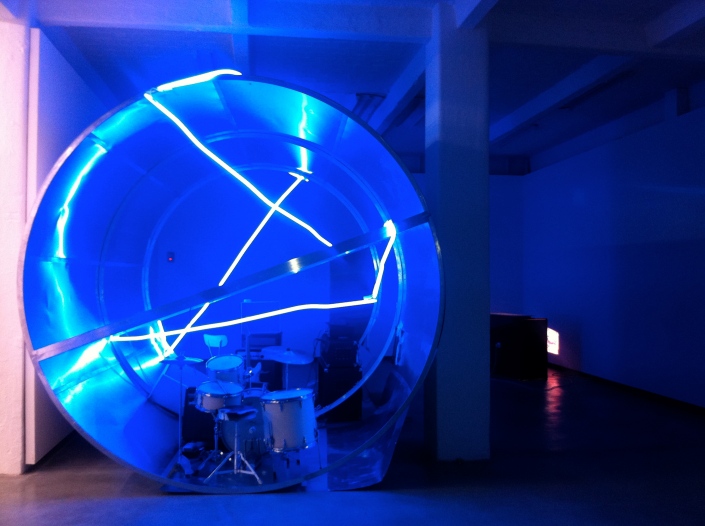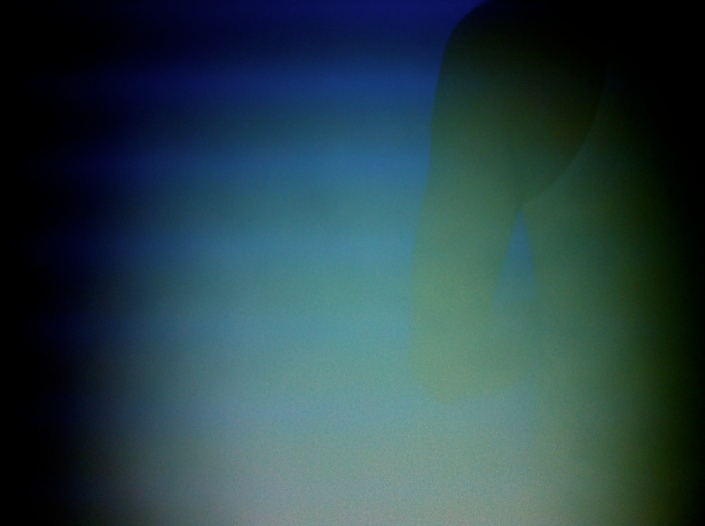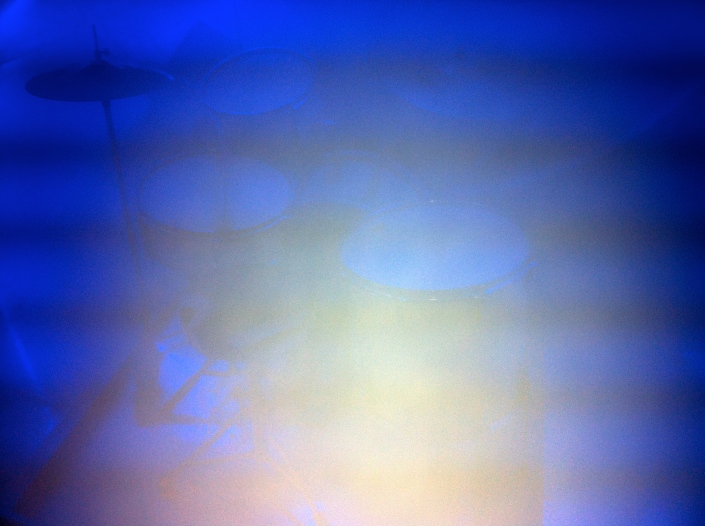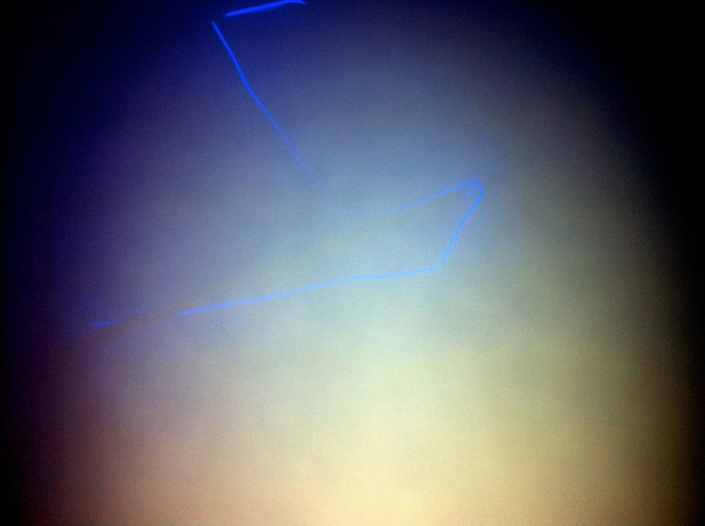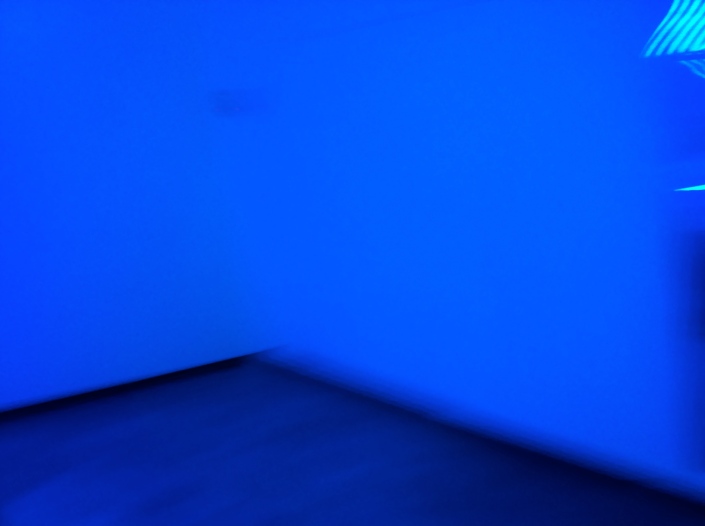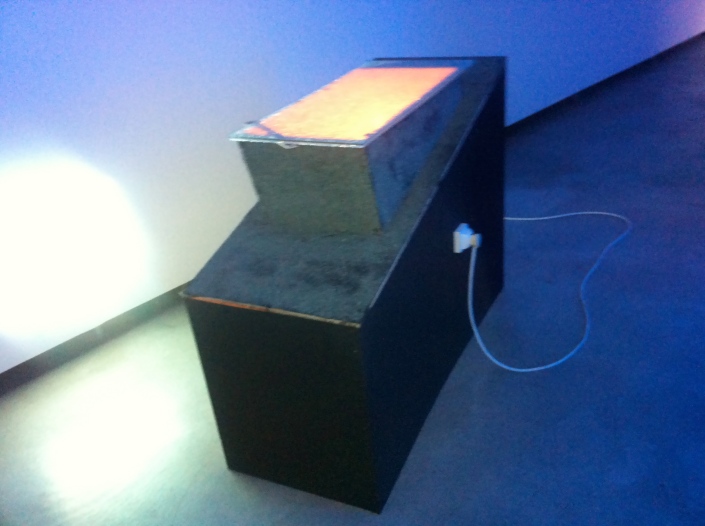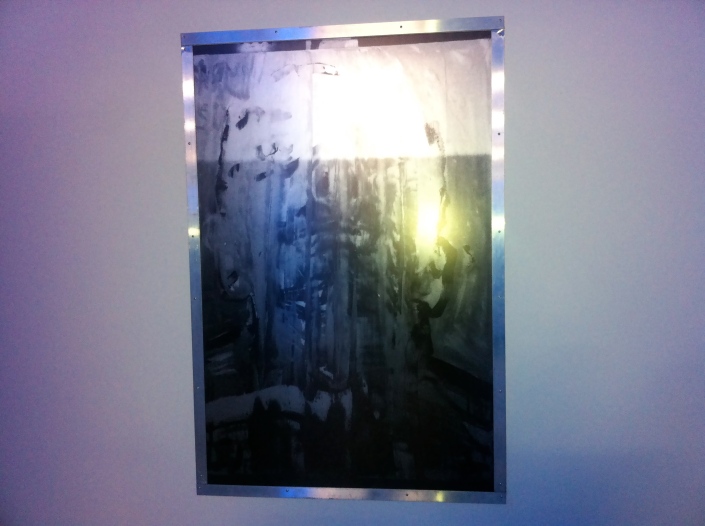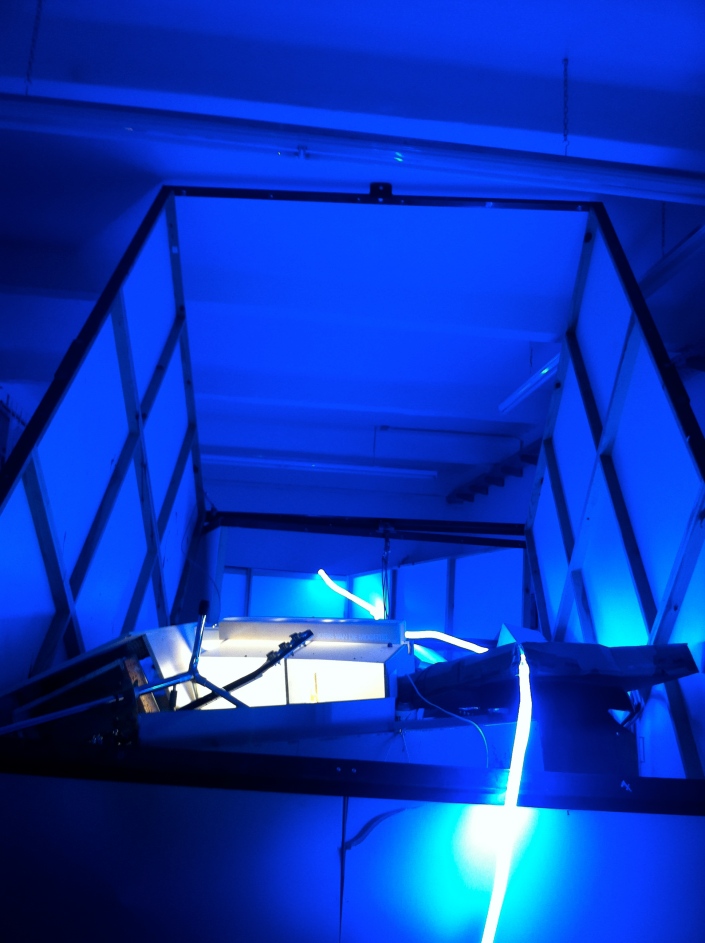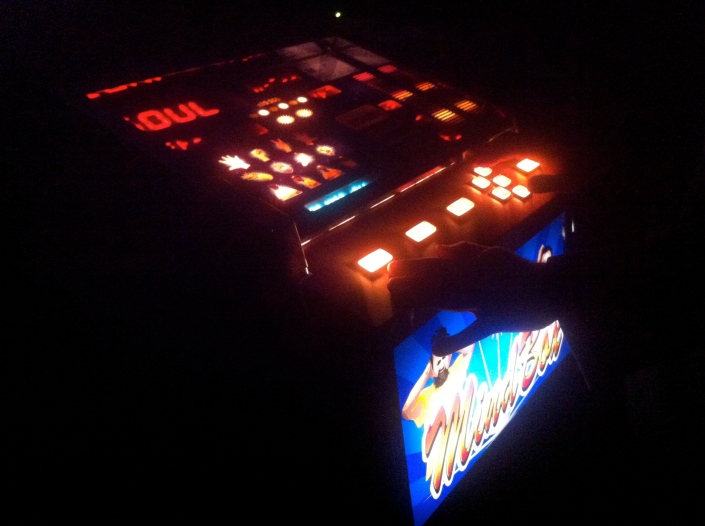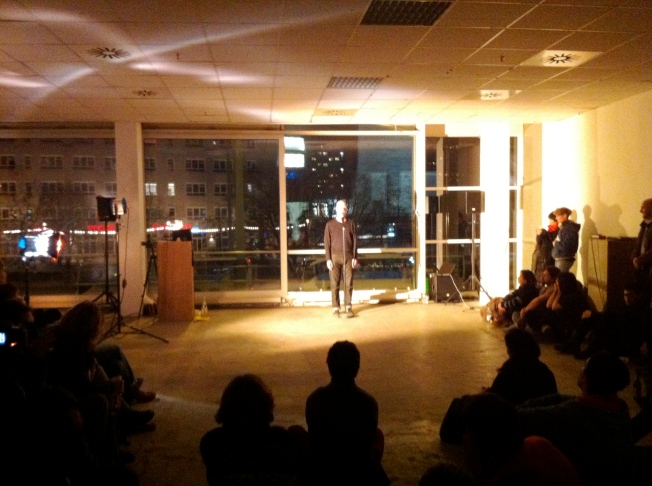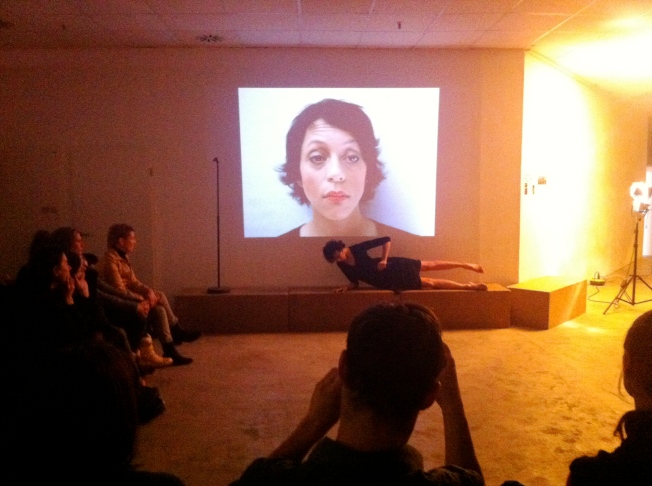Art Centre
‘Schwarz oder weiß, es ist mir gleich. Es gibt keine Farben in diesem blauen Reich’ Joris Van de Moortel @ Künstlerhaus Bethanien, January 17th, 2013
Joris Van de Moortel is concerned with architecture as an important medium of our mental and physical experiences of space. Besides musical performances, he creates assemblages, which often resemble stage sets or the remains of a performance. For his generally large-scale installation works, Van de Moortel uses pedestals, walls and boxes or a number of things that seem to have been found by chance: towels, musical instruments, door leaves, a single window, or an old cooking pot are combined into unpretentious artefacts, which seem to bear their own, expansive dynamics within them. The artist bundles, ties, screws, and then shuts up his work in wooden or acrylic glass cases, or he has them hang from the ceiling in bin-bags. His environments – often in conjunction with musical performances – are inspired by found situations and often they have no clearly defined beginning, middle or end. Thus, the artist often ‘recycles’ the work at the end of an exhibition by destroying it, and constructing a new work with the help of the resultant junk. In this way, the “undoing” in Van de Moortel’s work becomes an important aspect of the “doing”.
Joris Van de Moortel is a grantee of the Flemish Government in Künstlerhaus Bethanien. As the 17th of January were also Open Studios at Bethanien, this last picture is an installation in his studio.
The video below correspond to the last 25 seconds of the performance that accompanied the exhibition-installation… all is blue…
EXHIBITION: 18.01. – 10.02.2013. Tue – Sun: 2 – 7pm. Admission free.
Text source: http://www.bethanien.de/en/exhibitions/automatisch-gespeicherter-entwurf-2/
BodyControlled #5 @ LEAP, December 7th, 2012
INSTALLATIONS
MindBox – Christian Graupner (DE)
With the audio-visual triptych MindBox Christian Graupner & partners created an audience reactive installation and an electro acoustic music instrument using the body of a ‘one armed bandit’ as an user interface. MindBox is a part of the work cycle H.RP [Humatic Re-Performing].
The installation attracts visitors’ senses offering a joyful gambling- game around musical, choreographical and cinematographical elements as dance & beat-boxing. The latter expression describes a form of vocal percussion from which the installation derives its title. MindBox is a triple-channel ‘media catapult’ to be touched. The arm and buttons of the modified fruit machine function as a tactile interface to the actions of a filmed character whose vocal- & movement clusters can be re-composed and re-performed by the audience.
MindBox is an artistic collaboration between: Christian Graupner (GER) – Humatic, inventor, media artist, director, composer; Roberto Zappalà (IT) – performer, choreographer; Norbert Schnell (FR) – IRCAM Centre Pompidou, interactive music & sound design; Nils Peters (DE) – Humatic, system developer and software artist.
FeeedBack 5 *public prototype & casting module – Christian Graupner (DE) & Alan Gleeson (IE)
FB5pp demonstrates the evolving audio features of the pipelined multi-screen media installation FeeedBack 5.
One by one, female visitors are invited to put on headphones and to wear a “prepared” electric guitar. In doing this they accept to play the main role in an intense re-performance, by becoming a experienced feedback guitar player and creating their own rich soundscape .
A smartphone and additional sensors are mounted on the guitar to transmit accurate 3D motion and position data to an external system which provides a reactive real-time soundtrack giving direct response to players activity and creating a close-to-real simulation. Surrounding visitors can observe the player becoming one with the instrument in swaying movements but are not able to listen to the spectacular soundtrack.
In addition to being a standalone sound installation FB5pp fires the imagination for the pipelined multi-channel / multi-user audiovisual work FeeedBack 5 (http://fb5.humatic.net). The setup serves for casting and test shootings that will develop to the complex piece which will be realized in early 2013.
Concept and Realisation: Christian Graupner (Humatic) & Alan Gleeson. Guitar Feedback Footage: Blacky Schwarz-Ruszczynski, Project Partner: Dr. Prof. Werner Jauk, Universität Graz, Android: Control Software: Nils Peters ( Humatic). Additional Technical Support: Servando Barreiro & Jo Frgmt Gyrs
PERFORMANCES
Zunge lösen | Releasing the tongue – Christian Kesten (DE)
zunge lösen by Christian Kesten consists of the following elements: (fine) slaps of the tongue on the bottom of the mouth, (visible) tongue movements and tongue movements, which articulate a (chance) text, based on a given material of phones (syllables and smaller). Through breath and larynx they are made audible from time to time. Tongue movements, breath and voice function as independent layers which interact.
G is for Guam Flying Fox (Pteropus tokudae) – Christian Kesten (DE)
Über die Lebensweise des Guam-Flughunds ist nichts bekannt. [Nothing is known about the Guam Flying Fox’s way of living.] for voice, hands/arms, feet.
The piece was originally composed for Antonia Baehr and her Abecedarium Bestiarium.
Lips revisited – Carlos Sandoval (MX) and Etoile Chaville (FR)
Lips revisited is a study on gesture’s contrast and interpretation. The first version of the piece (an approach on microgestures) was premiered at LEAP with Almut Kühne one year ago. This time the piece is much more fragmented both in terms of its elaboration and its discourse. With Carlos Sandoval: Live electronics and actions and Etoile Chaville: Voice and dance
Go Karamazov – Eva Sjuve (SE)
Go Karamazov is an interface for live interactive performance, a wearable controller with sensors as inputs, reacting to movements of the performing body. The live audio is programmed in Pure Data and is addressing issues of electromagnetic propagation. Light has been integrated into the design adding a visual element of light and shadows. The sonic output from the controller is composed in relation to the movements of the performer.
Eva Sjuve has been developing interfaces for gestural use since the late 1990s. GO interface is an early wireless interface, developed in 2006 for the performing arts, as a Nordscen Artist in Residency. GO Karamazov was later commissioned by New Composers Series in New York, and premiered at PERFORMA 07 biennale in New York City, as one of the highlights. Go Karamozov is an interface that adresses issues of electromagnetic propagation, via a very free adaptation of Dostoyevsky’s novel the Brothers Karamazov.
DesertMed @ NGBK, October 26th, 2012
Desertmed is an interdisciplinary research project. The “blind spots” on the European map serve as its subject matter: approximately 300 uninhabited islands in the Mediterranean Sea. A group of artists, architects, writers and theoreticians travelled to about 40 of the —often difficult to access— islands in search of clues, impartially cataloguing information that can be interpreted in multiple ways. The result is a pool of photographs, audio and video recordings, presented along with further artistic contributions. They examine the myriad ways in which the individual islands are used and – accordingly – their significant political, economic, and historical interrelationships.
Artists: Fabian Bechtle, Bik van der Pol, Leon Kahane, Deborah Ligorio, Stefanos Tsivopoulos, Luca Vitone and the Desertmed Collective: Giulia Di Lenarda, Giuseppe Ielasi, Armin Linke, Amedeo Martegani, Renato Rinaldi, Giovanna Silva with contributions by:Elina Axioti, Giulia Bruno, Daniele Ansidei, Aristide Antonas, Antonia Dika, Laura Fiorio, Stefano Graziani, Franck Leibovici, Donato Ricci
Project Group: Fabian Bechtle, Wilfried Kuehn, Armin Linke, Marina Sorbello, Antje Weitzel
Text source: http://ngbk.de/development/index.php?option=com_content&view=article&id=256:desertmed&catid=11&Itemid=340&lang=en
Open Studios @ Künstlerhaus Bethanien, August 16th, 2012
On Thursday August 16th we were able to see Künstlerhaus Bethanien artists studios. The atmosphere in the studios was like a international artists dorm as they become scholars from different countries. Strolling through customized workshops, it was offered the exciting opportunity to see the artwork on the scene and deal directly with the artist.
Among this year’s artists, which are funded through the International Studio Program, include:
Mats Adelman (Guest Artist), Viktoria Binschtok, Mauro Cerqueira, Hadassah Emmerich, Jan Freuchen (Guest Artist), Roey Heifertz, Sharon Houkema, Hyein Lee, Michael Lee, Joris van de Moortel, Daniel Palacios, Linn Petersen, Judy Radul (DAAD ), Constantinos Taliotis, Aiko Tezuka, Mark Themann, Jane Ritchi, Rebecca Wilton, Daniel Young and Marie Zolamian.
‘The Box’, Paul McCarthy @ Neue Nationalgalerie, August 25th, 2012
McCarthy life’s work, which he has been creating since the 1960’s, was inspired by “primal themes” in American society and is characterized by irony, unmasking and the grotesque, as well as a complex nexus of interaction between media and materials. He makes use of Disneyland, comics, Hollywood and set pieces from art history. In his content-packed performances – which strain the limits of endurance – conceptual art, action painting, surrealism and minimalism seem to shift space. McCarthy introduces moments of the uncanny, of dislocation in space or masquerade, a situation that is reflected in the almost stage-like, three-dimensional collage “The Box” (1999): an oversized wooden box, into which McCarthy has built his entire studio, i.e. the setting for his creativity and the production of his artworks. The installation appears outwardly to be an inconspicuously simple trunk, yet inside a stunning variety of things that reference not only McCarthy himself, but his extensive creations from the beginning of his career to the present as well. The box with over 3,000 fixed objects from his studio – tables, equipment, tools or boxes – is tilted 90 degrees. Due to the rotation, it becomes an almost surreal spatial experience. This ties into McCarthy’s radical performance art and opens up new perspectives on the creative space.
As the single work exhibited in the expansive hall, “The Box” is granted particular significance. The narrowness of the studio – the private space – meets the expansiveness of the surrounding – the public space. At the same time, this artwork relates to the collection housed in the Neue Nationalgalerie, which is exhibited in the basement. Specific points of connection can be found to the cultural assemblage from the 1960’s exhibited here (Daniel Spoerris “Snare-picture”) or Bruce Nauman‘s early studio videos (“Bouncing in the Corner”). The view into the studio, a constantly recurring theme by modern artists, is in this version by Paul McCarthy the portrait of an unsparing artist who is willing to reveal everything.
Text source: http://www.smb.museum/smb/kalender/details.php?objID=32753
Martig, Westerlund, Zielony, Armstrong-Six @ Künstlerhaus Bethanien, August 16th, 2012
FRANÇOIS MARTIG – “The Dawn”
The artist François Martig uses a wide range of media, from sculptural and sound installations to radio documentaries and photography in his pieces. In addition to his visual work, he produces live sound and music performances as well as soundtracks combining soundscapes, field recordings, electro-acoustic music and noise. In 2005 Martig started working on his long-term project Robinsonhotel, where he explores landscape as an evolving socio-economic and political spatial entity and phenomenon. In reference to Robinsonhotel Martig created his exhibition “The Dawn” at Künstlerhaus Bethanien highlighting the human will to manage the landscape. The Zone Rouge (Red Zone) refers to an area of approximately 120.000 acres in what used to be First World War battle-ground in Northern and Eastern France. The war’s impacts on nature were so devastating that there are still measurable chemical residues in the grounds, which are closed to the public, whilst cities like Verdun have become hot spots for military tourism today. As a post-war decree, Germany gave France Black Pine trees to help reforest the land around Verdun. Currently this forest is known for its cheap timber. For his project “Zone Rouge” (2007-2012) Martig bought 1 m3 of pine timber from the area and brought it back to Germany. He combines the wood with postcards, which show an image of the former battleground and inform the viewers about this unknown story. In addition a wasteland occupies the gallery space with soil taken from the sculpture garden in Berlin and a two-channel film projected from a watchtower shows found-footage videos of the worldwide deforestation.
YLVA WESTERLUND – “Evolutionary throwback”
In her drawings, installations, performances, and videos Ylva Westerlund explores various scientific models of knowledge. By assuming alternate roles she switches between the artist-as- researcher to the subject of study itself. Westerlund’s work is influenced by her interests in social studies, post-structuralist feminism, and monsters. In the exhibition “Evolutionary throwback” Ylva Westerlund weaves a visual net, which oscillates between the past, present, and future of human evolution. Inspired by a visit to Berlin’s Natural History Museum – Leibniz Institute for Research on Evolution and Biodiversity and their displays of casts representing homo sapiens’ ancestor australopithecus anamensis, who has been extinct for four million years. Westerlund developed a complex multi-media installation presented as subjective scientific research. A part of it is her video “Evolutionary throwback” (2012). A plaster cast of the artist’s face as an australopithecus anamensis helps the artist to transform into a fictional creature, a mixture between homo sapiens and australopithecus anamensis, evoking notions of the art activist group Guerrilla Girls.
TOBIAS ZIELONY – “Zuspiel: Big Sexyland”
In a further edition of the ZUSPIEL-series, Künstlerhaus Bethanien presents the film “Big Sexyland” (2008) by photographer and filmmaker Tobias Zielony. In his works Zielony portrays groups of youths in desolate surroundings: the interchangeable peripheries of cities such as Berlin, Bristol, or Marseille. He works in the style of reportage, however, his images are not limited to simply documenting living conditions. Instead, he raises sociological questions: what types of signs construct these young-adults’ identity? What influence does their environment have on their understanding of self, what impact do they have on their environment? Zielony’s works combine and reflect a young seemingly lost generation’s issues of self-perception and judgement of others in the ghettos, prisons, and suburbia of our society. To produce the film presented in Künstlerhaus Bethanien Zielony followed young rent boys in a Berlin sex cinema and park over a period of several months. The film “Big Sexyland” (2008) is set in a Berlin sex cinema, which is not only a place of work, but serves as a “safe haven” for prostitutes. Zielony’s protagonist, a young man, is shown asleep, lying in one of the shabby upholstered seats of the projection area. The only source of light in the darkness is a porn film in the background. Projections outlining mechanical physical movements, monotonous moans and groans, envelop the sleeping young man. In his dreams, the young sex worker transcends the “Big Sexyland” represented in Western Europe, he seems far far away from his daily physical presence and sexual labour. His body is at the centre of Western capitalist society, fulfilling society’s promises – such as venal sex.
DAVID ARMSTRONG-SIX – “Civil Elegies From The Vacuum State”
For his exhibition at the Künstlerhaus Bethanien, David Armstrong-Six reinvestigates notions of materiality and objecthood in relation to sculpture. The ten new sculptures in wood, bronze, plaster and glass which are collected here under the umbrella “Civil Elegies From The Vacuum State” are meant as a series of ruminations which seem to emerge equally from the vestiges of dada, Cubism, Situationism and Minimalism. Indeed, the vacuum state, which is the lowest possible field of sustainable energy in quantum physics, is equated here with a studio-based practice and the cumulative conflation of a studio-based language. David Armstrong-Six is searching for the specific shape of sculpture between noble grace and mere refuse, high cultural pretensions and casual collage, technology and nature, between the minimalist’s material sensitivity and the surrealist’s faith in contingency, between familiar forms and un-forms, i.e. elements that have been deplaced, reworked or destroyed. Using statics that are often scarcely credible, he constructs networks within which things communicate.
Text source: http://www.bethanien.de/
‘Five minutes of pure sculpture’, Anthony McCall @ Hamburger Bahnhof, August 11th, 2012
For the first time, the work of the New York-based artist Anthony McCall will be presented in a solo exhibition at a German museum. McCall’s unique projections, which he has been developing since the 1970s, exist at the boundaries between cinema, sculpture and drawing: animated lines are projected in a dark room filled with a light haze, allowing viewers to step into the beam of light and change its appearance.
The Hamburger Bahnhof will be showing works that McCall created beginning in 2003 after a 20-year break. While the early works are shown on 16 mm film, his more recent works are digital projections whose complex forms can only be created with the aid of computers. McCall’s horizontal works will be exhibited for the first time alongside his more recent vertical works, which bathe the exhibition space and the viewer in sculptural light.Curated by Henriette Huldisch.
Text source: http://www.hamburgerbahnhof.de/exhibition.php?id=32936&lang=en
Photographs by Paco Arteaga
‘Self # Governing’, Marina Naprushkina, 7th Berlin Biennale @ KW, April 26th, 2012
Known in Western democracies as “the last European dictatorship”, Belarus became an independent country after the collapse of the USSR. It has been under the authoritarian rule of President Alexander Lukashenko since 1994. For years now he has used repression as a political tool against the opposition; civilians are at the mercy of the whims of the military, the Internet is under surveillance, and there is barely any free press. This is arguably the high price that the population has to pay for Lukashenko’s alleged, much-touted “stability” for the entire country.
Marina Naprushkina works in close collaboration with key figures of the cultural and political scene in Belarus in order to strengthen democratic processes in the country. 2011 saw the first edition of Naprushkina’s newspaper, Self # governing, whose aim is to develop future models for Belarus outside of the bloc-building confines of the EU or Russia. The newspaper’s Russian edition was widely circulated in Belarus thanks to the efforts of many activists. The second edition of the paper analyzes the patriarchal, masculinist system of government in Belarus. It shows how women themselves unwittingly perpetuate this model, and possibilities for changing the situation. Considering the recent wave of protest and resistance across the globe, Self # governing can be read – and used – as a guide for daring to think about political alternatives worldwide. Text by Martin Schibli.
Project partners: Kalmar Konstmuseum, Sweden; Krytyka Polityczna, Poland; Olga Karatch, Nash dom, Belarus; Marina Naprushkina and Irina Solomatina, Institute of Future, Belarus; Tobias Weihmann, Germany; Utrikespolitiska Institutet, Sweden.
Text source: http://www.berlinbiennale.de/blog/en/projects/self-governing-a-newspaper-of-marina-naprushkina-20074
